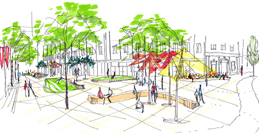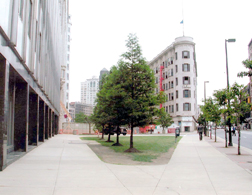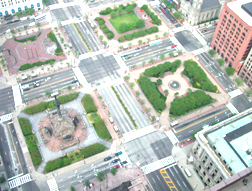A biweekly newsletter with public space news, resources, and opportunities.
A curated dispatch on all things public markets plus the latest announcements from the Market Cities Program.
Cleveland, OH - October 2002 Led by the nonprofit ParkWorks, Cleveland is undertaking an ambitious campaign to make the city more desirable to the information-age workforce.
Highly mobile "New Economy" employees have much greater mobility than previous generations, and the quality of parks and public spaces plays a major role in their choice of residence. As the steel industry declines in Northeast Ohio, the need to attract a solid New Economy work force increases, and so does the need for quality parks.
ParkWorks recognized early on that vibrant parks and lively streets are key to attracting new jobs to Cleveland.
"In order for Cleveland to compete, specifically as it seeks to bolster its regional image and significantly increase its downtown residential base," stated ParkWorks executive director Ann Zoller, "we need to create dynamic public spaces designed to complement the many other development efforts happening in the city."

With that economic necessity in mind, ParkWorks embarked on a process of identifying downtown greenspace opportunities in the summer of 2001. They specifically sought projects that could be completed within twelve months, in addition to opportunities for additional, longer-term projects.
After conducting interviews with downtown stakeholders--including development corporations, established arts institutions, architectural firms, and the Cleveland City Council--ParkWorks drafted a greenspace opportunity map for downtown. The map outlined greenspaces where improvements would have the most substantial impact for downtown's stakeholders.
Drawing from the opportunity map, ParkWorks drafted a prioritized list of short-term projects. These projects could all be completed within one year and would deliver the maximum "bang for the buck." They were chosen for their potential to improve the public perception of downtown for the lowest cost.

For example, the Plaza at Huron Point is currently a drab strip of sidewalk with great potential due to its location in the "gateway" area of downtown (so named because thousands of people pass through on their way to events at Jacobs Field and Gund Arena). Two new housing developments are adjacent to the site, meaning the proposed beautification would benefit residents, workers, and visitors alike. In addition, federal Transportation Enhancement Funding may cover 80 percent of the project cost.
The opportunity map signaled the beginning of an effort to comprehensively plan improvements to downtown's parks and waterfront. This July, ParkWorks expanded that effort by distributing a survey to over 2,500 downtown residents. The survey asked about their likes, dislikes and aspirations regarding downtown park and greenspace amenities.
The early returns gave greater urgency to ParkWorks' call to invest in parks. Sixty-seven percent of those surveyed said there were not enough parks downtown, and 61 percent said park programming was insufficient. Many participants called for increased lakefront access, pedestrian-oriented parks, and park activities that appeal to broad sectors of the community.
Recognizing the economic benefits of parks, formerly "strictly business" sectors of the Greater Cleveland community such as the Growth Association and Crain's Cleveland Business weighed in on the issue as well. Growth Association Executive Director Dennis Eckart was particularly outspoken about the need to create a system of active multi-purpose trails along the lakefront, and throughout Cleveland's neighborhoods and downtown.

The chorus calling for better parks has not fallen upon deaf ears. Mayor Jane Campbell has been very enthusiastic about park improvements. In fact, she pushed for a forum on the future of Public Square, one of Cleveland's most important public spaces. Held on October 19th and facilitated by Project for Public Spaces, the forum brought together 175 people representing various constituencies to develop a vision for this crucial area. Located by Terminal Tower, a multi-use transit hub at the heart of downtown, Public Square is divided into four segments by six-lane roads. The city closed the square to traffic for the event so participants could experience the effect a permanent closure would have.
The forum succeeded in communicating the immense benefits of an improved Public Square. "Some people who were previously not supportive of the idea left the meeting saying 'Hmmm, this makes a lot of sense,'" said ParkWorks Program Director Barb Clint.
In addition to the Mayor, ParkWorks has found an ally in the City Planning Commission. The dynamic young Planning Director, Chris Ronayne, wholly believes in the importance of greenspace, parks, and trails. His philosophy has shone through in the Commission's work: The Commission is spearheading many of the projects on ParkWorks' greenspace opportunity map, and they are updating citywide plans to reflect a new emphasis on parks and livability.
Clint says the partnership has been rewarding for both sides: "They feel energized and inspired by the potential before us. Together, we're focused on an impressive and ambitious agenda that can have a real impact on our city."
Thanks to ParkWorks and their partners in city government and the private sector, truly bold ideas are coming forth in Cleveland. As they revive the city's parks and public spaces, they redefine the city itself.
The rich text element allows you to create and format headings, paragraphs, blockquotes, images, and video all in one place instead of having to add and format them individually. Just double-click and easily create content.
The rich text element allows you to create and format headings, paragraphs, blockquotes, images, and video all in one place instead of having to add and format them individually. Just double-click and easily create content.
Body Text Body Link
The rich text element allows you to create and format headings, paragraphs, blockquotes, images, and video all in one place instead of having to add and format them individually. Just double-click and easily create content.
Here is some highlighted text from the article.




Headings, paragraphs, blockquotes, figures, images, and figure captions can all be styled after a class is added to the rich text element using the "When inside of" nested selector system.
Headings, paragraphs, blockquotes, figures, images, and figure captions can all be styled after a class is added to the rich text element using the "When inside of" nested selector system.
Headings, paragraphs, blockquotes, figures, images, and figure captions can all be styled after a class is added to the rich text element using the "When inside of" nested selector system.